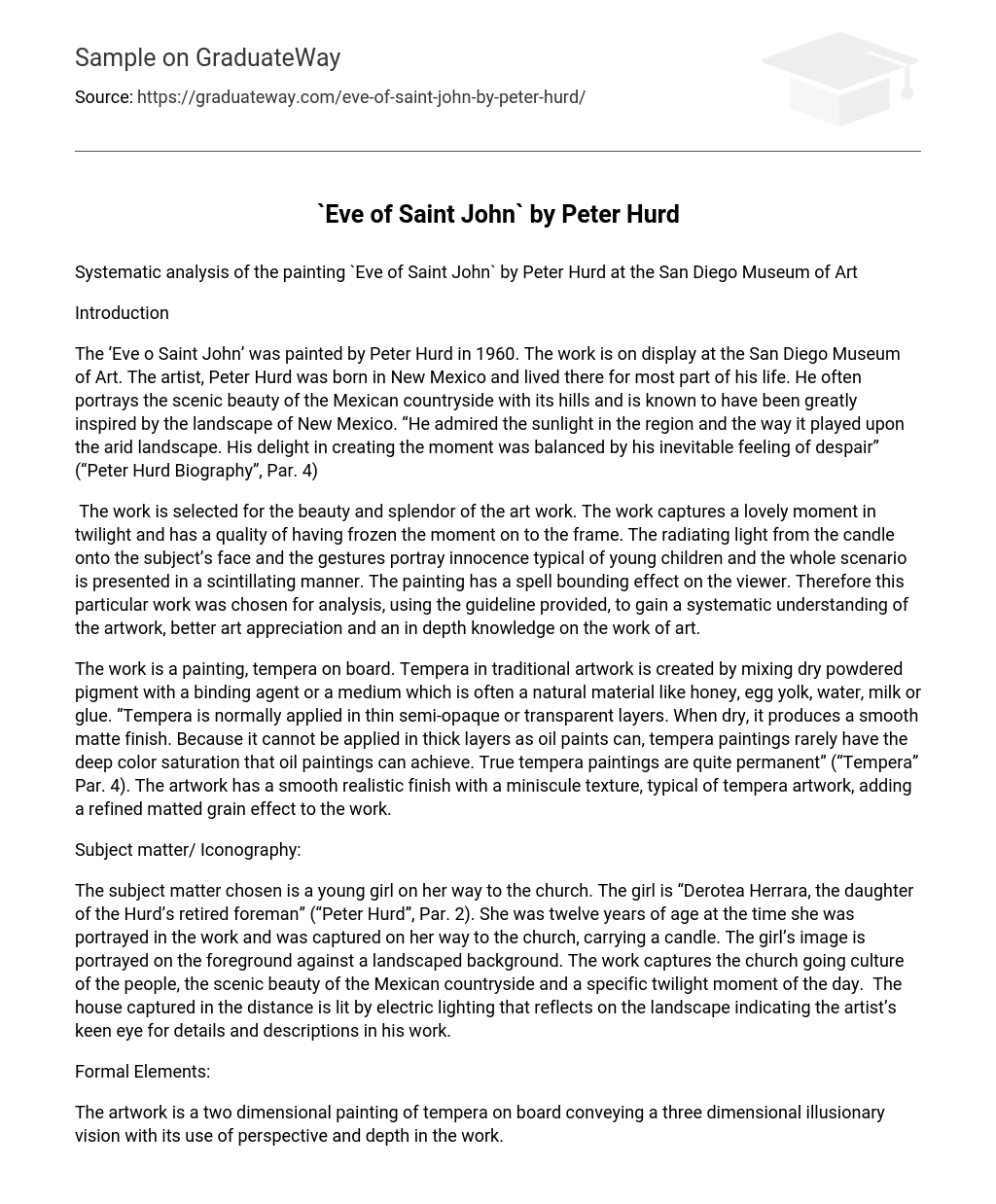Systematic analysis of the painting Eve of Saint John” by Peter Hurd at the San Diego Museum of Art.
Introduction.
The ‘Eve of Saint John’ was painted by Peter Hurd in 1960. The work is on display at the San Diego Museum of Art. The artist, Peter Hurd, was born in New Mexico and lived there for most of his life. He often portrays the scenic beauty of the Mexican countryside with its hills and is known to have been greatly inspired by the landscape of New Mexico. “He admired the sunlight in the region and the way it played upon the arid landscape. His delight in creating the moment was balanced by his inevitable feeling of despair” (“Peter Hurd Biography”, Par. 4).
The work was selected for the beauty and splendor of the artwork. It captures a lovely moment in twilight and has the quality of having frozen the moment onto the frame. The radiating light from the candle onto the subject’s face and the gestures portray innocence typical of young children. The whole scenario is presented in a scintillating manner. The painting has a spellbinding effect on the viewer. Therefore, this particular work was chosen for analysis using the guidelines provided to gain a systematic understanding of the artwork, better art appreciation, and an in-depth knowledge of the work of art.
The work is a painting created with tempera on board. In traditional artwork, tempera is created by mixing dry powdered pigment with a binding agent or medium, which is often a natural material such as honey, egg yolk, water, milk, or glue. Tempera is normally applied in thin, semi-opaque, or transparent layers, producing a smooth matte finish when dry. Because it cannot be applied in thick layers like oil paints, tempera paintings rarely achieve the deep color saturation that oil paintings can. However, true tempera paintings are quite permanent (“Tempera” Par. 4). The artwork has a smooth, realistic finish with a minuscule texture typical of tempera artwork, adding a refined matted grain effect to the work.
Subject matter/iconography:
The subject matter chosen is a young girl on her way to the church. The girl is Derotea Herrara, the daughter of the Hurd’s retired foreman” (Peter Hurd, Par. 2). She was twelve years of age at the time she was portrayed in the work and was captured on her way to the church, carrying a candle. The girl’s image is portrayed in the foreground against a landscaped background. The work captures the church-going culture of the people, the scenic beauty of the Mexican countryside, and a specific twilight moment of the day. The house captured in the distance is lit by electric lighting that reflects on the landscape, indicating the artist’s keen eye for details and descriptions in his work.
Formal elements:
The artwork is a two-dimensional painting of tempera on board that conveys a three-dimensional illusionary vision with its use of perspective and depth. In the foreground, the image of a young girl carrying a candle is portrayed. The reflection of the fading twilight and a brighter reflection of the candle, which the girl is carrying closer to her face, are captured by the contrasting use of light and shade. The distance on the two-dimensional plane between the plain surface and the mountains conveys a sense of three-dimensional space. The defining line of the human figure is differentiated from the rest of the landscape by the use of different colors. The contour lines of the distant hills are defined by a darker color that is almost black, conveying a sense of time. The sun’s reflection radiates behind the valley and is portrayed in varying shades of light differentiated by the use of colors like sunset yellow, soft orange, and shades of blue and grey. The composition captures the human figure and other surrounding elements: houses at a distance, the hills and the valley forming a background, the plains marking a distance between the girl and the hills, sun’s radiance, sky, and greens. A sense of proportion is achieved through scaling of the various objects. The houses at the distance appear to be miniature as they vanish in perspective away from the viewer. The various elements are portrayed in organic forms with more curves and angles and very little use of straight lines. Colors of moderate depth are used in the foreground, and deeper colors are used for the hills in the background. The color combinations are earthly and natural; bright skin tones, earthen brown for the plains, soft orange for the sun’s radiance, and dark shades for hills defining their contours are used. The left side of the frame, from the viewer’s point of view, is heavily loaded with details, and the right side has fewer elements, giving a sense of mystery and added focus on the main subject matter. The composition overall is well-balanced, and the various elements are artfully combined to give a picturesque view.
Detailing:
The girl’s facial features are finely detailed. The crinkles on her clothes, the brighter reflection of the candle on her face, spots of light from the houses at a distance, and varying depths of light and shadow are the finer details captured by the artist. The plain surface is detailed in colors of various hues and depths. The twilight effect is captured beautifully in the artwork.
Conclusion:
The work reflects the artist’s personal philosophy on originality and drawing inspiration from the natural landscape surrounding him. As the tempera work of art is long-lasting, this artwork may stand the test of time as a symbolic representation of the culture, clothing, landscapes, and artistic perspective of this period for many years to come.
Works cited.
Peter Hurd. N.d. San Diego Museum of Art. Retrieved from http://www.sdmart.org/Image1/Index.html on July 28, 2009.
Peter Hurd Biography. N.d. Retrieved from http://www.wyethartists.com/wyeth-family-artists/peter-hurd.htm on July 28, 2009.
Tempera. n.d. Retrieved from http://www.reviewpainting.com/tempera.htm on July 28, 2009.





